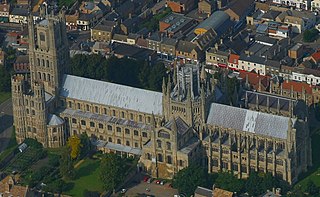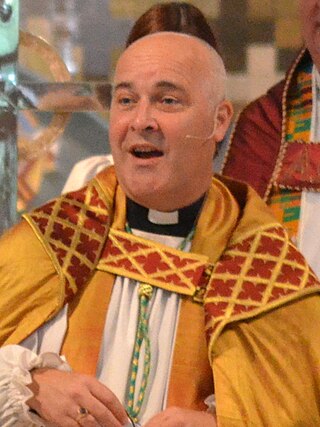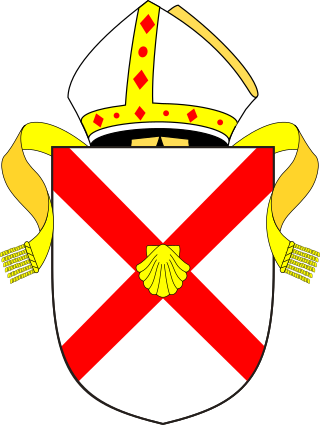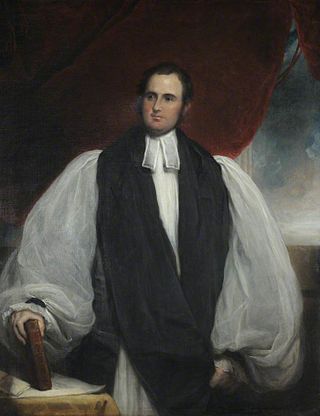Related Research Articles
Thomas Langton was chaplain to King Edward IV, before becoming successively Bishop of St David's, Bishop of Salisbury, Bishop of Winchester, and Archbishop-elect of Canterbury.
Walter Giffard was Lord Chancellor of England and Archbishop of York.

The Bishop of Norwich is the ordinary of the Church of England Diocese of Norwich in the Province of Canterbury. The diocese covers most of the county of Norfolk and part of Suffolk. The bishop of Norwich is Graham Usher.

Hervey le Breton was a Breton cleric who became Bishop of Bangor in Wales and later Bishop of Ely in England. Appointed to Bangor by King William II of England, when the Normans were advancing into Wales, Hervey was unable to remain in his diocese when the Welsh began to drive the Normans back from their recent conquests. Hervey's behaviour towards the Welsh seems to have contributed to his expulsion from his see. Although the new king, Henry I wished to translate Hervey to the see of Lisieux in Normandy, it was unsuccessful.
Alexander Neville was a late medieval prelate who served as Archbishop of York from 1374 to 1388.

John Waltham was a priest and high-ranking government official in England in the 14th century. He held a number of ecclesiastical and civic positions during the reigns of King Edward III and Richard II, eventually rising to become Lord High Treasurer, Lord Privy Seal of England and Bishop of Salisbury. He is buried in Westminster Abbey, London.

The archbishop of York is a senior bishop in the Church of England, second only to the archbishop of Canterbury. The archbishop is the diocesan bishop of the Diocese of York and the metropolitan bishop of the province of York, which covers the northern regions of England as well as the Isle of Man.

The Bishop of Worcester is the head of the Church of England Diocese of Worcester in the Province of Canterbury, England. The title can be traced back to the foundation of the diocese in the year 680. From then until the 16th century, the bishops were in full communion with the Roman Catholic Church. During the Reformation, the church in England broke away from the authority of the Pope and the Roman Catholic Church, at first temporarily and later more permanently. Since the Reformation, the Bishop and Diocese of Worcester has been part of the Church of England and the Anglican Communion.

The Bishop of Rochester is the ordinary of the Church of England's Diocese of Rochester in the Province of Canterbury.

The Bishop of Winchester is the diocesan bishop of the Diocese of Winchester in the Church of England. The bishop's seat (cathedra) is at Winchester Cathedral in Hampshire.

Charles Agar, 1st Earl of Normanton, was an Anglo-Irish clergyman of the Church of Ireland. He served as Dean of Kilmore, as Bishop of Cloyne, as Archbishop of Cashel, and finally as Archbishop of Dublin from 1801 until his death.
Roger Niger was a thirteenth-century cleric who became Bishop of London. He is also known as Saint Roger of Beeleigh.
Nicholas Bubwith (1355-1424) was a Bishop of London, Bishop of Salisbury and Bishop of Bath and Wells as well as Lord Privy Seal and Lord High Treasurer of England.
William de la Corner was a medieval Bishop of Salisbury, who had fought a long but unsuccessful battle to become Archbishop of Dublin.

Richard Marsh, also called Richard de Marisco, served as Lord Chancellor of England and Bishop of Durham.

Thomas Barnard was an Anglican clergyman who served in the Church of Ireland as Bishop of Killaloe and Kilfenora (1780–1794) and Bishop of Limerick, Ardfert and Aghadoe (1794–1806).
James Blakedon O.P., D.Th. was a medieval prelate who served as Bishop of Achonry from 1442 to 1453, then Bishop of Bangor from 1453 to 1464.
David FitzGerald was a medieval Bishop of St David's in Wales.

James Bowstead (1801–1843) was an Anglican clergyman who served in the Church of England as the Bishop of Sodor and Man (1838–1840) and Bishop of Lichfield (1840–1843).

Sir John Hotham, 9th Baronet, DD (1734–1795) was an English baronet and Anglican clergyman. He served in the Church of Ireland as the Bishop of Ossory from 1779 to 1782 and Bishop of Clogher from 1782 to 1795.
References
- Fryde, E. B.; Greenway, D. E.; Porter, S.; Roy, I. (1996). Handbook of British Chronology (Third revised ed.). Cambridge: Cambridge University Press. ISBN 0-521-56350-X.
- Thornbury, Walter (1978). "Westminster Abbey: Chapels and royal tombs". Old and New London. Vol. 3. London: Cassell, Petter & Galpin. pp. 431–450. Retrieved 17 January 2017– via British History Online.
- Jones, B., ed. (1963). "Archbishops of York". Fasti Ecclesiae Anglicanae 1300-1541. Vol. 6, Northern Province (York, Carlisle and Durham). London: Institute of Historical Research. pp. 3–5. Retrieved 17 January 2017.